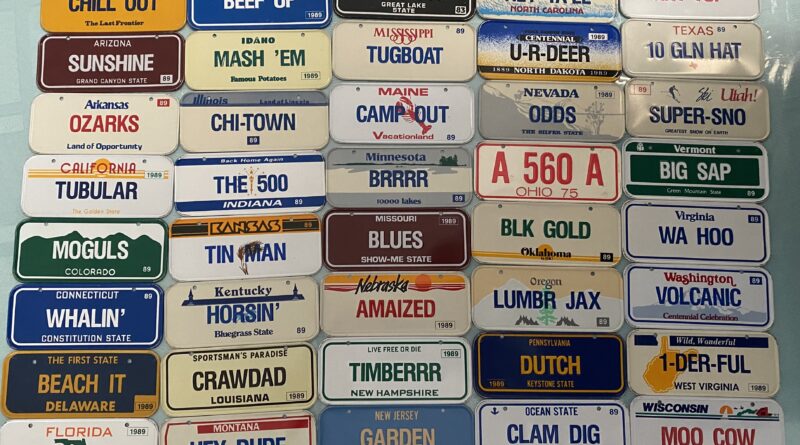License Plates Serve As a Happy Reminder of Past Travels
For many, the purchase of a new or used car or truck is the second most expensive consumer product they will ever buy. And the initial price of a vehicle is only the beginning of a long list of additional fees. These fees include taxes, insurance, licensing and registration, parking, extended warranties, repairs, and the list continues. However, in my more than 50 years of driving, I have come to appreciate one item unique to every vehicle: the license plate.
This low-tech metallic plate on the vehicle helps law enforcement identify individual cars and trucks. This information is necessary for all motor vehicle activity from parking tickets to apprehending bank robbers.
ALPR- Automated License Plate Readers
The need for security has become a priority, and the Department of Homeland Security and FEMA (Federal Emergency Management Agency) have grants available to help fund this newest security-enhancing tech innovation. ALPR security cameras have become an important and advanced high-tech tool. Police departments and first responders have been using these license plates and readers for years.
GrantWatch has a category for technology grants on its site, as well as one for homeland and national security grants.
Today, diverse entities from hotels to shopping malls and even the local neighborhood citizens’ watch are utilizing ALPRs to read and catalog the license plate number of each vehicle that enters its property.
The basic ALPR is a high-tech camera that only records a timestamped video of the plate. Cities use it at toll plazas and in red-light cameras. The more advanced and more expensive readers have optical character recognition. This captures the plate number, digitally stores, sorts, and compares the number to the database it creates. This database could help identify vehicles. This information would become evidence to apprehend trespassers, identify stolen cars, and anything else associated with that vehicle.
Collecting License Plates, a Life’s Journey
Folks collect almost anything: dolls, stamps, teacups, snow globes, books, records, etc.
Personally, I have collected state and provincial motor vehicle license plates. They are a unique souvenir of my travels. Since I believe that life is a journey, these plates have become my passport stamps.
The older I get, the more I have journeyed through the years into the unknown.
Recently, I was watching the launch of the Blue Origin from a launchpad in Texas. Fictional Captain Kirk of the Starship Enterprise; William Shatner, finally traveled to space, not on a movie set, but on an actual rocket, at the age of 90. The day after his journey, he expressed that as he peered out the window during his short space journey, he looked at the Blue Planet and saw life, and with his 90-year-old eyes he saw the blackness of space and saw death.
From the moment we are born to the moment we die; we journey and keep moving forward even though we do not know where or when the journey will end. Life is a journey; physically, spiritually, emotionally, psychologically, and intellectually. We are all trying to arrive at a place of love, peace, and happiness, as we try to understand our destiny.
Every time I took a journey, I knew that I was leaving my comfort zone to travel to the unknown. Why did I do that? Because, in order to grow, develop, and mature, I needed to leave my parochial and limited preconceptions behind. I had to take the risk of discovery, instinctively knowing the reward would always be worthwhile.
I Remember a Fable I Heard Years Ago
A poor man from a small town dreamed that treasure was under the bridge of the neighboring town. The dream was so detailed that he believed it and traveled to that bridge with a shovel in hand. As soon as he arrived at the location of his dream he immediately started digging for the treasure.
A local man noticed this stranger digging and politely inquired what he was doing. When the visiting stranger explained his dream of buried treasure, the local citizen responded that he too had a dream. He dreamed that treasure was in the poor man’s town and explained that his dream was so vivid that he even remembered the address of the house where the treasure was.
Amazingly, the address was that of the poor man’s modest home. The homeowner was shocked. He quickly returned home to start digging in his own backyard and found treasure.
The moral of the story is that sometimes we need to travel to an unknown place. We need to leave our environment, our biases, and our communal influences. Only then, can we discover our own treasure, independent of preconceived beliefs? Only after leaving, can we discover the treasure that is lying buried in our own backyard.
I enjoy admiring my colorful license plate collection, which decorates the interior walls of my garage. When I glance at them, I reflectively recall the places the license plates describe in their slogans. For example, I am reminded that Delaware is, “The First State”, and Florida, “The Sunshine State.” I enjoy describing the events of the places they represent, and I don’t even need an ALPR camera.
And then I enjoy my own home and environment for the peace and tranquility of writing from home and working remotely.

